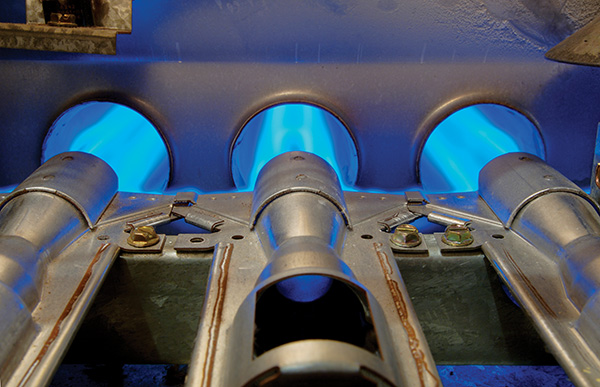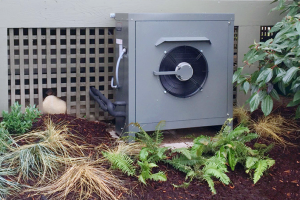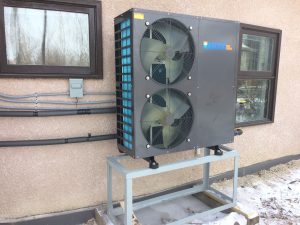
Gas-fueled Systems Under Fire
September 15, 2020 | By Rob Waters
Phasing out millions of fossil fuel fired heating units is one of many actions required to enable Canada to reach its emission reduction targets.

(Getty Images)
The push is on from many levels of government to go “low carbon”, reduce greenhouse gas (GHG) emissions and address climate change. The HVAC sector is part of this push, and one result is that traditional oil- and gas-fired heating equipment is under pressure. Governments would like to see this equipment become extinct. What does this mean for the hydronic industry and contractors?
There are several examples of recent government policies indicating that traditional fossil fuel heating equipment in Canada may be on the way out. Space and water heating equipment are certainly being targeted due to the fact that residential and commercial buildings account for 17% of total greenhouse gas emissions in Canada. Space heating represents 56 to 64% of the energy use in homes and buildings, and water heating represents 8 to 19% of the energy use.
The Pan-Canadian Framework on Clean Growth and Climate Change outlines the commitments of the federal, provincial and territorial governments to reduce greenhouse gas emissions and promote clean, low-carbon economic growth for Canadians. These governments have set aspirational goals for energy-using heating equipment in the building sector that reduces greenhouse gas emissions significantly.
To support the transition to a low-carbon economy, governments approved the “Market Transformation Road Map for Energy Efficient Equipment in the Building Sector” at the Energy and Mines Ministers’ Conference in August 2018. This plan sets short- and long-term goals for space and water heating equipment.
The short-term goal requires that by 2025 all fuel-burning technologies for space heating for sale in Canada must meet an energy performance of at least 90% (condensing technology).

Heat pump water heater (source: www.rheem.com)
The long-term goal states that by 2035 all space heating technologies for sale in Canada meet an energy performance of more than 100%. This goal would see the transition of the entire space and water heating market to heat pump technology or integrated gas absorption heat pump systems.
These ambitious goals still have a long way to go to become reality, however the writing seems to be on the wall … traditional fossil fuel boilers, water heaters and furnaces are under threat of being phased out.
Vancouver’s Strategy
The City of Vancouver is one jurisdiction that is taking greenhouse gas emission reduction very seriously. Vancouver’s “Renewable City Strategy” has set a long-term target to have all buildings in the city (including those already built) use only renewable energy by the year 2050.
Vancouver has a head start on most jurisdictions around the world as its electricity supply is already close to 100% renewable. BC’s grid is over 97% renewable due to hydroelectric generation and therefore has very low GHG emissions. As a result, while electricity conservation remains important, the focus of the Vancouver plan is on reducing the demand for fossil fuel space heating and hot water heating. The plan is to transition these functions to renewable sources such as electricity and bio-gas.
In July 2016, Vancouver moved its plan forward by introducing their “Zero Emissions Building Plan” which requires the majority of new buildings in Vancouver to have no operational GHG emissions by 2025, and all new buildings have no GHG emissions by 2030.
Under this plan Vancouver introduced the “Green Buildings Policy for Rezonings” in May 2017, which targeted new high-rise multi-unit residential buildings. The latest bylaw amendment from May 2020 will require all new residential buildings three storeys and under to install zero-emission space and water heating starting in January 1, 2022.

Vancouver is predicting that air-to-water heat pumps are likely to be a common heating solution for new single-family homes. (source: www.nordicghp.com)
The next step is anticipated in 2025, when both new and replacement heating and hot water systems must be zero emissions. The city anticipates this shift towards zero emission space and water heating will be met with heat pumps.
Vancouver is predicting that air-to-water heat pumps are likely to be a common heating solution for new single-family homes, as over 90% of typical single-family homes built in 2019 were heated with hot water. Water heaters will need to be electric resistance or heat pump water heaters.
Toronto’s Take
The City of Toronto’s “TransformTO” plan includes a set of long-term low-carbon goals and strategies to reduce GHG emissions, improve health, grow the economy and improve social equity.
Toronto aims to achieve Net Zero buildings by 2050. The plan has targets for all new buildings to be built to produce near-zero GHG emissions by 2030. By 2050, all existing buildings will have been retrofitted to improve energy performance by an average of 40%. Toronto has not yet introduced any low-carbon equipment requirements.
Challenges to Net Zero
There are immense challenges and barriers to reach the goals set by these new policies. For low-carbon or zero emission equipment, the market transformation roadmap outlined by the Energy and Mines Ministers’ Conference outlines the “five A’s of market transformation”:
- Availability: Does the technology exist?
- Accessibility: Does the market have access to the technology?
- Awareness: Does the market know about the technology?
- Affordability: Is the technology affordable?
- Acceptance: Is the form, fit, and function of the technology acceptable?
There are several examples of low-carbon space and water heating equipment that are currently being utilized in the Canadian market. Space heating systems can utilize electric resistance heating systems such as baseboards, forced air furnaces and hydronic boilers. All of these products have been available and accessible for a long time, and offer affordability, public awareness and acceptance. The main issue that resistance heating has working against it is the high cost of electricity in many regions of Canada.
Heat pump options include both air and ground source (geothermal). Heat pumps are much more efficient than resistance electric, typically providing two to four times higher efficiencies. Air source and geothermal heat pumps are available to either provide heat to a forced air distribution system or to a hydronic heating system. Both air source and geothermal systems have high water temperature limitations, with neither type working very effectively above 140F.
Geothermal heat pumps provide the highest possible operating efficiency, with consistent year-round performance, but also have the highest installation cost due to the expense of adding vertical or horizontal ground loops.

Air-to-water heat pump (source: www.arcticheatpumps.com)
Air source systems have good performance when outside temperatures are mild, however they can see a significant drop off in performance when the ambient air temperature drops much below -15C. Heat pumps have been around for many years, but the market for the different types has fluctuated based on performance issues (air source) and government subsidies (geothermal).
Air source heat pumps have seen a resurgence in recent years, especially in the Atlantic region. Heat pumps are widely accessible and generally have good market awareness, however barriers still exist with affordability (especially geothermal) and acceptance.
In their market transformation roadmap National Resources Canada (NRCan) identified a number of challenges and barriers to transitioning to low-carbon ground source, air source and gas heat pumps. These include technical barriers such as: the performance of air source heat pumps at low ambient temperatures (as mentioned), a lack of standardized test procedures for rating the energy performance of air-source units, high cost for installation of geothermal, retrofit challenges that will add cost and require additional components and controls, variability of commercial building stock and the challenges in remote communities.
They also identified market barriers that include product availability and training requirements for designers, contractors and building owners. Governments envision gas absorption heat pumps playing a major role in the future for low-carbon heating systems, as they may offer a significant increase in performance beyond that of existing gas-fired heating systems. However, they still face barriers to availability, accessibility, awareness, affordability and acceptance because they are not yet commercialized in Canada.
Electrical Grid
Two big stumbling blocks to a full low-carbon transformation across Canada are the affordability and availability of electricity supply.
While energy costs vary in different regions of Canada, the reality in most areas is that the cost of electricity is much higher than natural gas. Carbon taxes will gradually increase the cost of natural gas, with the federal carbon tax prices currently at $20/tonne, rising to $50/tonne by 2022.
Natural gas still remains abundant and inexpensive in Canada however, and even with the carbon tax added on will likely remain the preferred choice in most areas for years to come.
Natural gas is currently widely available and serves over 7 million customer locations and over two-thirds of Canadians. There are currently over 570,000 km of underground transmission pipes bringing natural gas across the country.
A transition to high levels of mandated electrification will require a costly expansion of Canada’s electrical infrastructure. Presently only 20% of our energy requirements are met by electricity.
With all of these challenges the transition to low-carbon equipment will likely hit speed bumps along the way. The economics alone will make it difficult to convince consumers to change from natural gas to more costly electricity.
Momentous Transitions
Transitioning to heat pumps will require expensive retrofit costs and electrical service upgrades for many buildings. Finding space to add the heat pump outdoor condensing may be difficult for buildings with tight building lots. Added noise from the outdoor units is something customers will have to get used to.
The mechanical industry will have to transition as well, with new equipment and installation techniques to learn. These hurdles will require intensive marketing and information strategy from governments, utilities and the HVAC industry to get consumers on-side.
While the transition may appear difficult, the benefits of reducing GHG emissions cannot be overlooked. Phasing out millions of fossil fuel fired heating units is one of many actions required to enable Canada to reach its emission reduction targets. This transition should create a boost in economic activity, requiring skilled workers and create demand for new equipment.
This will certainly benefit the HVAC industry, and the reduction of GHG emissions will certainly benefit the planet. <>





